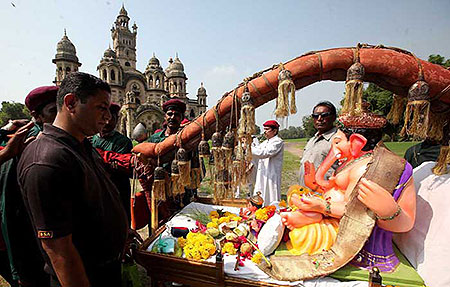Every year the entire world sees the Indian community celebrate Ganesh Chaturthi with great enthusiasm and participation. Preparations for this sacred festival begin months in advance and the actual day of celebration sees a grand observance of the occasion complete with elaborate execution of traditional rituals, singing of devotional songs, fervid dancing, cracker-bursting and loud chanting of "Ganpati bappa morya..." TheHolidaySpot brings to you a precise article on the celebrations of Ganesh Chaturthi. Learn how Ganesh Chaturthi is celebrated annually in India and the different customs that mark Ganesh Chaturthi festivities. If you like our article "How is Ganesh Chaturthi celebrated", do not forget to click here and refer it to your friends and loved ones. Shubh Ganesh Chaturthi!

With barriers breaking and distance between them receding, different countries and cultures have come closer. One of the holiest festival for Hindus, Ganesh Chaturthi is celebrated in every nation where there is even a small Hindu population. Yet, nowhere is the festival celebrated with as much grandeur and gaiety as in India.
In India, Lord Ganesha happens to be one of the most popular deities and everyone seems to be in love with this cute, pot-bellied elephant god. Naturally, Ganesh Chaturthi is quite a big affair in the country. The occassion sees pious worships to Lord Ganesha, the deity of prosperity who is also believed to the remover of all obstacles, and also joyous celebrations in honour of the divine being.
About two or three months before Ganesh Chaturthi, life-like clay models of Lord Ganesha are constructed and sold by skilled artisans. These beautiful statues depict Lord Ganesha in variuous poses, sometimes in a dancing mood, at other times with a small drum or in a simple sitting pose with one hand showering blessings on the observer. The artisans, many of whom make a living out of creating idols, compete with each other to make bigger and better sculptures of the Lord resulting in some magnificient creations that captivate the attention of spectators. The sizes of the relatively larger ones range anywhere from 10 meters to 30 meters in height. Most of these statues are life-sized figures but can also be smaller, of about one or two feet.
While the preparations for the festival begin months in advance with the starting of the creation of the idols, the occassion actually begins with the installation of these statues. Some of the idols are bought for individual celebrations and set up in beautifully decorated houses. But these are mostly bought by committees for public celebrations. Public celebrations of Ganesh Chaturthi are highly popular in India and the occassion witnesses marquees or temporary constructions (known as pandals) being specially erected in every locality in the days leading up to the festival. These stuctures, which are erected with monetary contributions from the local inhabitants, are decorated as beautifully as possible with flowers, lights, foams or other ornamental items. On the actual festive day, idols of the Lord are installed in every pandal and a priest, generally dressed in a red silk dhoti and shawl, performs a holy ritual known as "Pranapratishhtha" to invoke life into the statue amidst the chanting of sacred verses (mantras). This ritual is followed by another one called "Shhodashopachara" (16 ways of paying tribute). Items like coconut, 21 durva (trefoil blades of grass, 21 modakas, jaggery and red flowers are offered to the deity. The statue of the Lord is anointed with a red mixture of kumkum(saffron or turmeric) and chandan (sandalwood paste). All through the ceremony, Vedic hymns from the Rig Veda and the Ganapati Atharva Shirsha Upanishad as well as the "Ganesha stotra" from the Narada Purana are chanted.
The duration of the Lord's stay varies from place to place. Usually Ganesh Charturthi is celebrated for 10 days, from Bhadrapad Shudh Chaturthi to the Ananta Chaturdashi. People try to make a visit to as many pandals as possible with their friends and family and get a "darshan" (view) of the deity. On the 11th day, after a final offering of coconuts, flowers and camphor, every idol is taken through the streets in a procession and immersed in nearby lakes or river or sea. Every one, old and young, joins Lord Ganesha in his farewell journey but with festive merriment as the deity is believed to take away with him all the misfortunes of his devotees. They dance and sing songs and play with color on this day. The idol is given a "visarjan" (immersion) amidst loud chants of "Ganesh Maharaj Ki Jai!" (Hail Lord Ganesh). People make pleas to the Lord to return the next year with chants of "Ganpati bappa morya, pudcha varshi laukar ya" (Hail Lord Ganesh, return again soon next year). The procession and immersion is accompanied with dancing and the sound of exciting drum-beats, devotional songs and exploding firecrackers.
The festival is celebrated most grandly in the states of Maharashtra, Tamil Nadu, Karnataka and Andhra Pradesh and many other parts of India. Tourists from all over the world come to witness this wonderful event in the sun kissed beaches of Goa and Mumbai.
Looking for Something? Search Google :